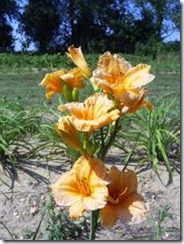Daylilies bloom over weeks although each blossom lasts only one day. For most of the summer, one variety or another of this prolific perennial nod along roadways or in gardens until fall when brown scapes stand above untidy mounds of grassy leaves. A bit of early fall cleanup never hurt a daylily and can extend the presence of its graceful foliage.
What Daylilies Want
-
Most daylily plants survive very nicely for their entire lives with minimum attention consisting of periodic division and light mulch. The optimal time for propagation is autumn, when daylilies are entering dormancy. After a summer when blooms have been thin at the center, reinvigorate the plants by division. As plants begin to die back and look raggedy, trim them back to about 6 inches tall, lift and divide the crowns and re-set the divisions in new holes lined with compost and humus. Divide daylilies every three to five years, depending on varieties. Replace summer mulches in fall with a light winter mulch made of fresh garden soil, compost and twice-mulched leaves. Lay winter mulches about an inch thick around but not touching the base of the fans; winter mulch protects roots, not the leaves.
Daylilies and Fertilizer
-
Daylilies are descended from wild plants and have naturalized themselves all over the world in a dozen climates. They don’t need fertilizer to grow in your garden. Some hybrids will bloom longer and more brightly, however, if given a scattering of slow-release garden fertilizer. The Southwest Indiana Daylily Society recommends a 6-12-12 (higher rates of phosphorus and potash) or general garden 10-10-10 fertilizer, depending on your soil. (See Reference 1) Early fall—right after the period of bloom has concluded—is the best time to fertilize daylilies.
Preparing for Winter
-
The scapes that hold daylily blooms also bear the fruit, or seed pods, of the plants. The seeds in these pods are seldom true to the plant that bears them because daylilies are not self-pollinators. Collecting seeds from cross-pollinated (and hand-pollinated) plants is an adventure for hobbyists. The process saps energy from the rest of the plant, though. If you aren’t interested in growing plants from seeds, remove scapes and seed pods to prolong the vitality of the plant; occasionally, plants will re-bloom in autumn if scapes have been removed as the last blooms fade in summer. As daylily leaves begin to get long and tattered, trim outer leaves on the fans to keep the plant looking neat through fall. When the first freeze kills most other plants, daylilies will hang on. Trim all but evergreen varieties back to about 6 inches before mulching. Although foliage can be left in place over the winter, fall grooming denies winter shelter to garden voles and other rodents and saves time during spring cleanup.


Deprecated: strpos(): Passing null to parameter #1 ($haystack) of type string is deprecated in /home/agriviek8Qv/agriviet.net/public_html/wp-includes/comment-template.php on line 2522